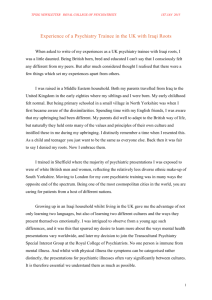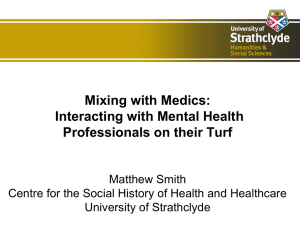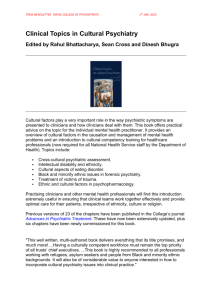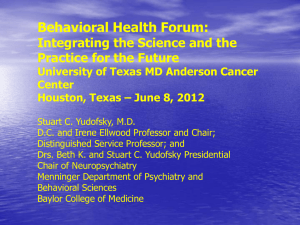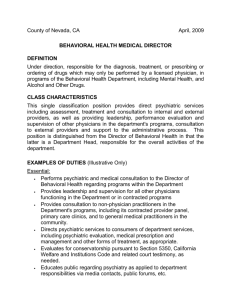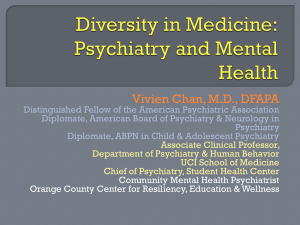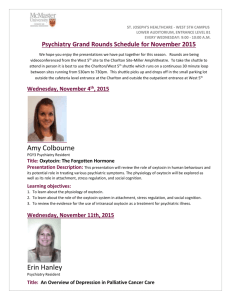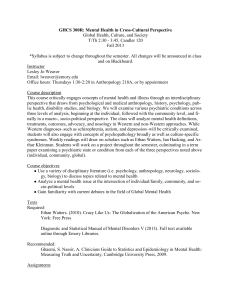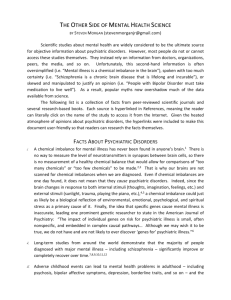Shrinks. The Untold Story of Psychiatry.
advertisement
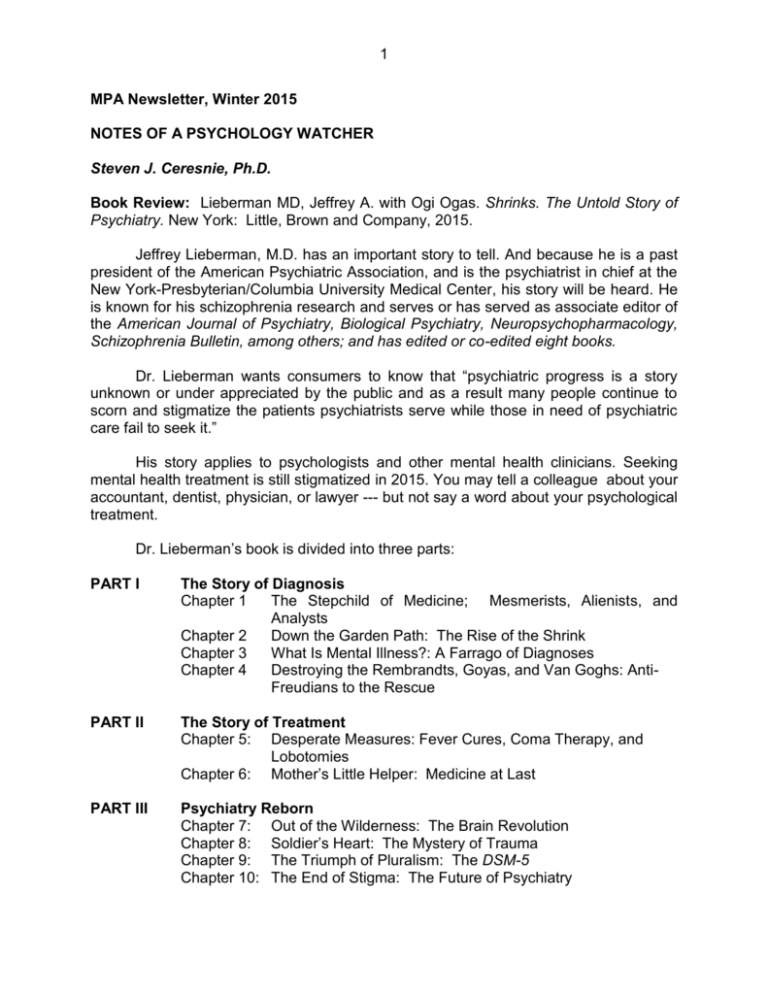
1 MPA Newsletter, Winter 2015 NOTES OF A PSYCHOLOGY WATCHER Steven J. Ceresnie, Ph.D. Book Review: Lieberman MD, Jeffrey A. with Ogi Ogas. Shrinks. The Untold Story of Psychiatry. New York: Little, Brown and Company, 2015. Jeffrey Lieberman, M.D. has an important story to tell. And because he is a past president of the American Psychiatric Association, and is the psychiatrist in chief at the New York-Presbyterian/Columbia University Medical Center, his story will be heard. He is known for his schizophrenia research and serves or has served as associate editor of the American Journal of Psychiatry, Biological Psychiatry, Neuropsychopharmacology, Schizophrenia Bulletin, among others; and has edited or co-edited eight books. Dr. Lieberman wants consumers to know that “psychiatric progress is a story unknown or under appreciated by the public and as a result many people continue to scorn and stigmatize the patients psychiatrists serve while those in need of psychiatric care fail to seek it.” His story applies to psychologists and other mental health clinicians. Seeking mental health treatment is still stigmatized in 2015. You may tell a colleague about your accountant, dentist, physician, or lawyer --- but not say a word about your psychological treatment. Dr. Lieberman’s book is divided into three parts: PART I The Story of Diagnosis Chapter 1 The Stepchild of Medicine; Mesmerists, Alienists, and Analysts Chapter 2 Down the Garden Path: The Rise of the Shrink Chapter 3 What Is Mental Illness?: A Farrago of Diagnoses Chapter 4 Destroying the Rembrandts, Goyas, and Van Goghs: AntiFreudians to the Rescue PART II The Story of Treatment Chapter 5: Desperate Measures: Fever Cures, Coma Therapy, and Lobotomies Chapter 6: Mother’s Little Helper: Medicine at Last PART III Psychiatry Reborn Chapter 7: Out of the Wilderness: The Brain Revolution Chapter 8: Soldier’s Heart: The Mystery of Trauma Chapter 9: The Triumph of Pluralism: The DSM-5 Chapter 10: The End of Stigma: The Future of Psychiatry 2 Dr. Lieberman takes us on grand rounds back in time to meet the well-respected charlatans of the day selling silly, ineffective and gruesome psychiatric treatments: the orgone box; purging of the bowels; the rotational chair; and lobotomies. Dr. Lieberman goes on to educate us with some “inside baseball” stories such as how psychiatrist Dr. Robert Spitzer brought together the warring factions in psychiatry -- the psychoanalysts, the biological psychiatrists --- to negotiate the “revolutionary” Diagnostic and Statistical Manual of Mental Disorders in 1980 that was based on reliable symptoms for the psychiatric disorders; the story of how some psychiatrists successfully fought to remove homosexuality as a psychiatric disorder from the DSM; and the controversial rise-up of the anti-psychiatrists such as Drs. R.D. Laing (1) and Thomas Szasz (2). Dr. Laing viewed schizophrenia as a necessary growth experience and refused to shackle the minds of psychotics with psychiatric drugs. When Dr. Laing had a schizophrenic daughter, his private beliefs about schizophrenia changed. Dr. Szasz, the author of the popular book, The Myth of Mental Illness, joined forces with the Scientologists to bash psychiatrists. Dr. Lieberman omits important discoveries in his review of the history of psychiatry. For example, he neglects the most important studies of personality in the 20th century: The Minnesota Twin Studies (3). These remarkable studies of identical twins reared apart and then reunited and examined as adults taught us the important role of genetics in determining all of our personality traits. The behavioral geneticists tell us the more we learn about the role of nature, the more we learn about the effects of nurture on personality development. We are not born with minds of blank slate. Because of our genetic research, gone are “facts” promoted by famous book-writing clinicians who spent years blaming refrigerator mothers for producing autistic children; or blaming parents communicating in ambiguous double-binds creating the schizophrenic child. We are lucky to live in 2015, a time when there is much psychologists and psychiatrists can do to alleviate the suffering of patients with bipolar disorder, schizophrenia, and attention-deficit/hyperactivity disorder, to name a few. But what is bipolar disorder?, or schizophrenia?, or ADHD? The DSM-5 is a reliable field guide of psychiatric disorders, consisting of an observable list of ingredients for many psychological disorders with no recipes for the causes or etiology of any of the mental maladies. To ask what mental illness is ---- is to get answers that sound muddle-headed or simple-minded In his book (1) What is Mental Illness? (4), Harvard psychologist Richard J. McNally devotes each of his brilliant chapters to such questions as “Are We 3 Pathologizing Everyday Life?”; Is it in Our Genes?; Is Psychopathology an Adaptation?” Dr. McNally’s concluding chapter asks: “So What is Mental Illness Anyway?” To answer what mental illness is, Dr. McNally turns to the work of psychiatrist Dr. Paul McHugh (5) who contends that the diversity of mental health conditions tends to fall into four clusters or perspectives. Dr. McHugh proposes that although we have made huge gains in our knowledge about the workings of the brain, we do not know how the brain produces the mind ---how consciousness flows from brain tissue. Psychologists cannot go directly from understanding the elements of the physical brain (e.g. neurons, neurotransmitters) to explaining a patient’s conscious mental experience. To get around this brain-mind gap, and to organize bio-psycho-social clinical information, Dr. McHugh argues we must try to understand people with psychological disorders from four perspectives: 1. Perspective of Diseases: Diseases such as Bipolar Disorder and Autism result from a faulty “hard drive” where “broken” brain based problems are assumed to cause symptoms. 2. Perspective of Dimensions: People with traits on the extremes of a dimension of intelligence (such as mental retardation) or personality (such as shyness) are more easily provoked to psychological distress. 3. Perspective of Behaviors: Abnormalities in goal-directed behaviors or what people do, such as eating or drinking, including problems with addictions. 4. Life Story Perspective: Here we look at what people encounter over their lives --- such as divorce, poverty, or trauma --- that leaves some people with “faulty directions,” about how to cope. These perspectives are complementary ways of looking at people with psychiatric problems --- each perspective requires a different set of concepts and treatment approaches. For example, pharmacotherapy is often effective for patients with Bipolar Disorder. Psychological therapies are often the treatments of choice for patients with life-stories that leave them shaken, emotionally unsteady, demoralized or discontented. Towards the end of his book, Dr. Lieberman applauds the progress of modern day psychiatry. He says, “The modern psychiatrist now possesses the tools to lead any person out of a maze of mental chaos into a place of clarity, care, and recovery…such psychiatry has arrived at last.” Yet psychiatry and psychology are elementary arts based on science at the level of chemistry before Mendeleev began to fill in the periodic table of elements. Much of our therapeutic efforts are based on rules of thumb that are difficult to prove. 4 In these days where clinicians are too quick to use the tools of checklist shortcuts to make differential diagnoses; apply quick fixes of medication without knowing the patient; and to minimize the benefits of long-term psychotherapy, we have many more “miles” of research on fundamental principles to claim that psychology and psychiatry have “arrived.” Our arrival time is many years away. References: (1) Laing, R.D. The Divided Self. London: Tavistock Publications, 1959. (2) Szasz, Thomas. The Myth of Mental Illness. New York: Harper & Row, 1960. (3) Bouchard, T.J., Jr. Lykken, D.T., McGue, M., Segal, N., Tellegen, A. The Sources of Human Psychological Differences. The Minnesota Twin Studies of Twins Reared Apart. Science 250, 1990. Pages 223- 228. (4) McNally, Richard J. what is mental illness? The Belknap Press of Harvard University Press. Cambridge: 2011. (5) McHugh, Paul R., and Slavney, Phillip R. The Perspectives of Psychiatry. The Johns Hopkins University Press. Baltimore: 1998. Second Edition.
